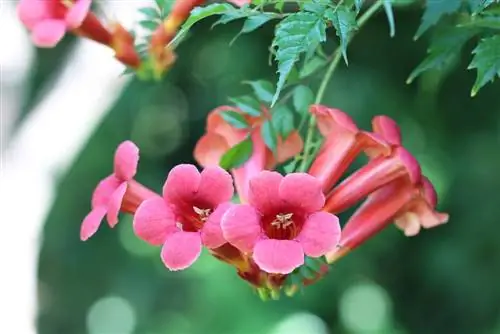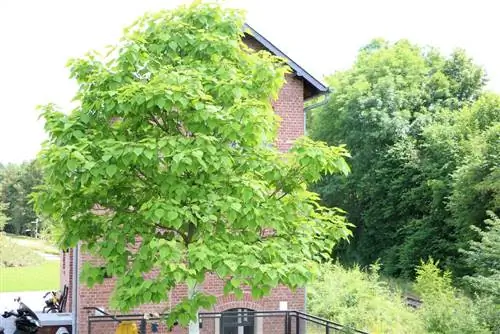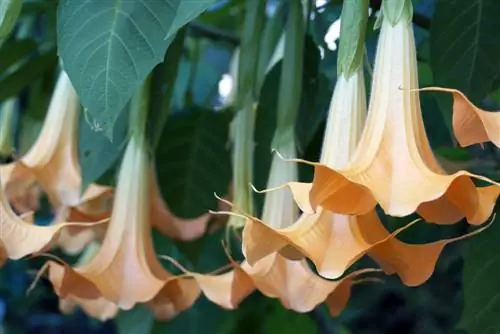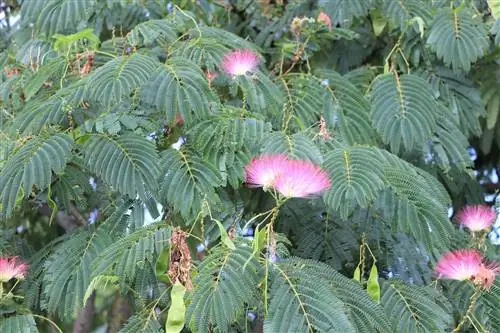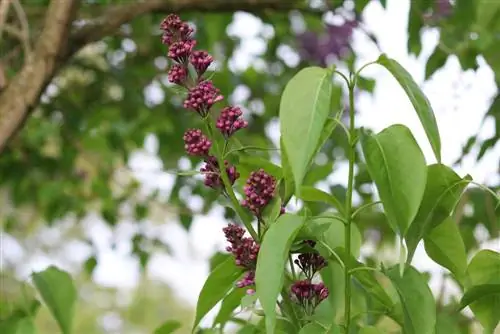- Author admin [email protected].
- Public 2023-12-17 03:39.
- Last modified 2025-01-24 12:45.
The phenomenal trumpet tree conquers gardens and parks with its majestic stature. It has made a name for itself particularly as an avenue tree. The Catalpa bignonioides nana has become an excellent cultivar for small areas, thanks to its harmonious spherical crown. Where their natural growth cannot be given a free hand, proper pruning makes a significant contribution to preserving the unique habit of both ornamental trees. Find out here how to prune a trumpet tree and benefit from useful tips for Catalpa bignonioides nana.
The right time
The exotic growth behavior of the trumpet tree defines the optimal date for a shape and maintenance pruning. If the tree is assigned a location in a mild, frost-protected location, it will present its enchanting panicle flowers in bright white in June and July. While the dense foliage is shed without any autumn color, the deciduous tree is already laying the buds for next year's flowers. At the same time, the elongated pod fruits develop. These remain on the tree throughout the winter and contribute significantly to its ornamental value. Only when temperatures rise the following year do the fruits open to distribute the seeds. The scope for choosing the ideal time for pruning is therefore quite limited. The following two alternatives are recommended:
- Prune the trumpet tree in early spring, shortly before the new shoots
- Cut to shape in August, after flowering and before the new buds appear
- On the deadline there will be dry, frost-free weather without bright sunshine
A cut in early spring inevitably affects the fruit cover that still exists at that time. In addition, a certain level of experience is required in order not to damage the established buds and thus deprive yourself of this year's flowering. August therefore comes into focus, as dry, warm weather forces wound closure.
Tip:
Every tree cut affects the animals living in it, such as birds or bats. Therefore, no pruning measures should be carried out during the breeding season from March 1st to July 31st.
The best cut

The sprawling crown of a trumpet tree is naturally shaped so harmoniously that cutting is only considered if there is not enough space available or the deciduous tree has suffered frost damage. Anyone who quickly grabs the pruning shears and shortens the branches that are too long will regret their hasty action. This approach results, on the one hand, in the branches appearing as if they had been amputated and, on the other hand, reacting with broom-like shoots. In order to preserve the wonderful growth habit of the trumpet tree, a derivation cut meets the expectations placed on it much better. Here's how to do it:
- Sharpen the cutting tool freshly and disinfect it with alcohol
- In the first step, thin out the crown thoroughly
- Cut all dead wood and shoots that are too close together on branches
- Don’t leave long stubby “coat hooks”
- Cut off shoots that are directed towards the inside of the crown and grow crosswise
- Dive each branch to be shortened onto a weaker one that serves as a new tip
- Make each cut at a slight angle just above an outward-facing eye
- Tear out all vertically growing water shoots
Each thicker branch is cut in two steps to avoid a fraying wound. First, saw the branch from below and then cut it off completely from above. If necessary, the cut is smoothed with a knife and the edges are coated with a wound closure agent.
Head tree cutting
The common trumpet tree is one of the few deciduous trees that are suitable for pollarding or de-topping. Hobby gardeners decide on this drastic measure in order to get even larger specimens of their unique heart leaves from the exotic tree. Sometimes the cutting form is used if the tree creates too strong a shadow. The trumpet tree is cut down to a few main branches or even the trunk. As a result, a very long process of patience is required until the scaffolding has developed into a handsome tree again. Since not all tree species can tolerate this radical pruning, oaks, for example, are protected from it by the Tree Protection Ordinance.
Tips for Catalpa bignonioides nana
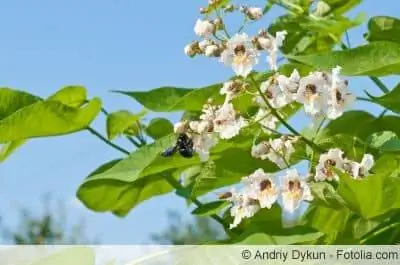
With the breeding of the ball trumpet tree 'Nana', the mighty trumpet tree was excellently adapted to the spirit of the times, which calls for smaller house trees. Grafted on a standard stem, the small cultivar develops a round crown characterized by the distinctive heart-shaped leaves. There is no flowering and the resulting fruiting here. With a maximum height of 200-300 centimeters and an annual growth of 5-10 centimeters, the ornamental tree is also suitable for small gardens and pot cultivation.
The best time
With a Catalpa bignonioides nana, no flower limits the choice of the appropriate date for a shape and maintenance pruning. Therefore, experienced hobby gardeners opt for a day in late winter, as the ball tree has no leaves at this time. This fact simplifies the incision and ensures a better overview to maintain the round crown shape.
The right cut
As with its 'big brother', a ball trumpet tree basically does not require pruning. If the ornamental tree grows to an undesirable size over time, Catalpa bignonioides nana still proves to be pleasantly easy to cut. Given the slow growth rate, pruning is only possible every 3 to 4 years. The following cut is recommended:
- Thinning out dried and stunted branches
- Tear off water shoots and side shoots below the grafting point
- Cut branches that rub against each other and grow out of shape up to the branch ring
- Shorten the branches overall so that stronger specimens are diverted to thinner branches
The topiary cut went properly if at the end the light reached all areas of the crown. In this way you can effectively prevent aging from within.
Tip:
The derivation cut only prevents a broom-like new shoot if the branch to which it is derived is not too flat.
Repair storm damage
If a spherical trumpet tree falls victim to storm damage, the battered hobby gardeners can rarely avoid radical pruning. Due to the gaps created in the crown, even weaker winds now find enough areas to attack, so that branches will continue to break. Untopping, as with the common trumpet tree, is not an option here. As a result, the beautiful spherical shape would be gone and would no longer develop. Instead, the wild rootstock sprouts heavily and completely overgrows the graft. How to properly repair storm damage on Catalpa bignonioides nana:
-
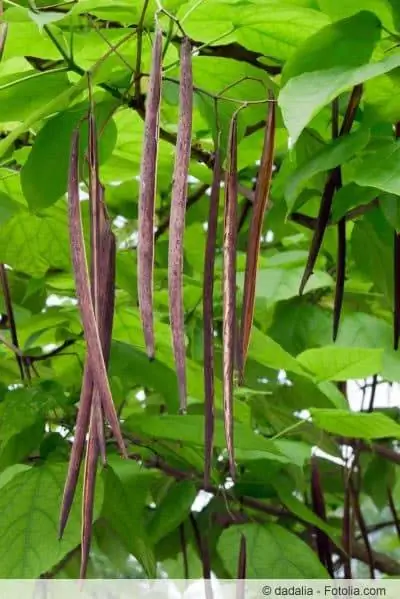
catalpa bignonioides The optimal date is on a frost-free day in late winter
- Alternatively immediately after the storm, but not in spring when the tree is in sap
- Above the finishing, shorten the crown to the size of a football
Again, targeted derivation is of utmost importance if you want to avoid unsightly broom sprouts. Positioning the scissors above an outward-facing bud will promote harmonious growth after cutting. Branches with inward-facing eyes should be removed completely as they are not expected to make a useful contribution to the round crown.
Conclusion
A majestic trumpet tree develops its magnificent stature without the need for topiary pruning. However, if the deciduous tree is too large, there is no reason not to prune it. The best date for this measure has proven to be a dry day in August, immediately after flowering and before new buds are planted. The short-growing cultivar Catalpa bignonioides nana, on the other hand, only requires pruning in exceptional cases, which preferably takes place in late winter. Anyone who takes the derivation technique into account for both ornamental trees will be rewarded with lifelike growth.


